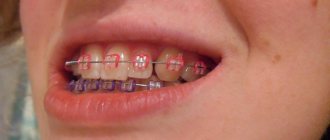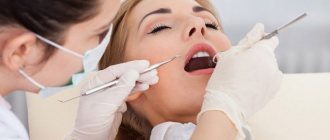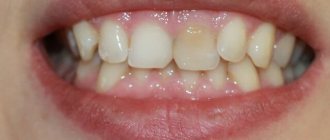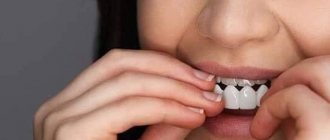Common reasons
Darkening of teeth can look different:
- If the discoloration is caused by plaque that is not properly removed, the color of the dentition appears uneven, darker at the base and lighter towards the edges; Possible causes are abuse of coffee and tea (strongly brewed drinks have a powerful coloring effect) and smoking. It is very difficult for tea, coffee and nicotine lovers to maintain a snow-white smile; they practically have to choose between beautiful teeth and established habits.
- If one or more teeth have a pronounced color difference, we have to talk about poor-quality canal treatment or the development of secondary caries (after removal of the nerve, the darkening of the tooth is explained by the lack of nutrition and is natural; a dark rim around the filling is a signal for its immediate replacement due to a violation of the tightness ). A tooth can also be darkened by trauma that causes nerve death or internal bleeding; whiteness can only be restored through careful treatment of the canals, sometimes with intracanal bleaching.
Black plaque is not only a death sentence for a smile, but also a possible cause of caries. Only regular visits to the dentist will help you avoid troubles and keep your teeth healthy and white.
What to do to get rid of the smell
Some patients, even having discovered that the cause of such bad breath was a tooth rotting under the crown, for some time they hope to cope with the problem on their own: they rinse their mouth with decoctions of chamomile, calendula, and sage.
Antibacterial rinses and traditional medicine give a temporary effect and are not able to eliminate the root cause of the problem. In addition, frequent rinsing can disrupt the normal microflora of the oral cavity, when beneficial microorganisms die along with harmful ones.
It should be understood that no home remedies will stop the inflammatory process in the tooth, which will only progress and lead to its complete destruction and loss.
Why do children's teeth turn black?
While many explanations can be found for the darkening of tooth enamel in adults, black teeth in a child cause bewilderment and confusion among parents. In fact, a child’s teeth can darken even with careful hygiene and in the absence of chronic diseases.
There are several reasons for the problem, the main one is improper nutrition with the amount of sweets in the diet: microbes, like people, love sweets, the effect of sweet food on tooth enamel is negative, associated with the appearance of a dense microbial biofilm. Other common reasons:
- genetic predisposition
- calcium deficiency
- dysbacteriosis
- early caries
If you notice dark gingival stripes on your child’s teeth, do not ignore them: the appearance of the so-called Priestley’s plaque is one of the consequences of the development of the digestive system, which resolves itself with age, but it is better to clarify the diagnosis with a dentist. Dark spots and dots on the baby’s teeth should also cause concern: contrary to the popular belief that baby teeth should not be treated, in the absence of adequate treatment, permanent ones that grow to replace them are often damaged.
Black teeth in a child are an alarming signal that requires an immediate preventive examination by a dentist, since all pathologies develop rapidly in childhood.
Treatment tactics vary and depend on the following factors:
- stages of tooth decay;
- the degree of spread of the inflammatory process to soft tissues;
- condition of root canals.
Treatment options for a tooth under a crown:
If the tooth stump has been preserved and has not undergone a carious process, the layers inside the crown are cleaned and, depending on the condition, it is either replaced with a new one or returned to its place after restoration.
When the upper part of the tooth is destroyed, but the roots are healthy, the stump inlay method is used. This is an orthopedic structure with “legs” that are fixed in the canals of the tooth, and an artificial crown is installed on top.
If the putrefactive process has gone too far and the tooth is completely destroyed, it is removed. As a rule, with long-term inflammation, the soft tissues surrounding the problematic tooth also suffer. Therefore, before proceeding with prosthetics, periodontitis is treated. There are two ways to restore a lost tooth: implantation or a bridge.
When choosing a dental clinic where you plan to get dentures, be sure to find out whether the medical institution provides guarantees for the treatment performed. If damage to the prosthesis occurs during the warranty period due to a medical error, treatment and restoration of the orthopedic structure is carried out free of charge.
Black teeth: treatment methods
What can you do at home?
It is well known that you can make your teeth lighter by quitting smoking and limiting your consumption of coloring drinks such as strong coffee and tea.
Another obvious requirement is regular brushing of teeth with the addition of additional dental hygiene products (dental floss, rinses, etc.)
On the Internet you can find many recommendations for changing the shade of tooth enamel using folk remedies, but you should not rely on such solutions, since only professional hygiene and whitening give real results. Don't self-medicate!
If you decide to see a dentist
At the first appointment, provide the specialist with as much information as possible about your health, lifestyle and bad habits - this will help the dentist quickly and accurately stop the cause of the pathology.
If the darkening is due to tooth decay, recent nerve removal, or other dental problems, treatment will be required. Today, dentistry fights for every tooth, offering solutions even in situations that seem hopeless, including restoring teeth with crowns or veneers.
The method of treatment is selected individually based on the general condition of the oral cavity.
The main reasons why a tooth under a crown begins to smell bad
Wearing a prosthesis longer than expected . Over time, when wearing a denture for a long time, the gum tissue atrophies, and the area of the neck of the tooth is exposed. A loose connection of the crown to the gum causes the formation of a gap into which food debris gets trapped. It is impossible to remove accumulated substrate from under the crown using traditional methods: toothbrush, rinsing. As a result, an environment favorable for the growth of bacteria is formed under the crown, which in the course of their life emit foul-smelling sulfur dioxide gases.
Violation of the seal between the crown and the tooth . The reason is most often the incorrect installation of the prosthesis or the resorption of the material that was used to fix the artificial crown to the supporting tooth. Pathogenic microflora, penetrating into the formed cavities, causes secondary caries and inflammation of the gums.
If the crown is metal-ceramic, then under the influence of salivary secretions and oxygen in the air, the metal in its composition undergoes oxidation, which causes an unpleasant odor. In addition, the resulting oxides irritate the mucous membranes of the gums and can provoke allergic reactions.
Lack of tooth protection after grinding . One of the stages of preparation for prosthetics is preparation - removal of the enamel coating, which protects tooth tissue from mechanical damage and the action of microbes. If, before installing a permanent prosthesis, the ground tooth is not covered with a temporary crown or treated with cement, then bacteria settle on it and continue their destructive activity under the prosthesis.
Violation of the technological process of manufacturing and installing a prosthesis . If a crown is installed incorrectly, regardless of the reason (insufficient experience of dental technicians and orthopedists, use of low-quality materials), soft tissue injury occurs, followed by infection and the development of inflammation.
Poor oral hygiene . Artificial structures - dentures require special care and cleaning. If you neglect the rules of hygiene, pathogenic microorganisms begin to actively multiply, causing putrefactive processes.
Poor quality dental treatment . One of the main conditions for successful prosthetics is the absence of infection in the oral cavity. If teeth that are subject to prosthetics have a defect in filling the dental canals, a granuloma or cyst filled with pus may form at the apex of the root.
When teeth affected by caries appear under the crown, the decay process continues and ends with complete destruction and death of the tooth.
Methods for treating black teeth
- If black streaks or stains appear on the teeth due to improper care, professional hygiene is prescribed. In our clinic you can sign up for a “denticure”, your teeth will be free of plaque, and your smile will be attractive again
- If your teeth are blackened due to food dyes, then professional or home whitening, using special toothpastes and eliminating coloring foods from your daily menu will help.
- If your teeth have turned black due to caries, then sanitation with further restoration of the tooth and preventive procedures to strengthen your teeth are necessary. No dentist will remove black teeth without understanding the cause.
Provide thorough and competent oral care - and you will never know what black plaque is. See a dental hygienist to learn how to properly brush your teeth and choose a toothbrush and toothpaste.
What is the prevention of plaque formation?
The first step is to completely abandon the harmful habit of smoking and frequent consumption of drinks that form black plaque on the teeth. It is imperative to diversify your diet with solid foods and fiber-rich vegetables, fruits, and cereals. Chewing such food thoroughly helps to naturally cleanse tooth enamel. Timely and properly organized hygienic care of the oral cavity is the basis for preventing the occurrence of plaque on teeth. In addition, do not forget to visit the dentist regularly, even if nothing bothers you.
So, as soon as a specialist can assess the state of plaque and notice problems with teeth in the initial and curable stage. Dental treatment and care requires regularity, strict adherence to specialist recommendations and a professional approach.
Bacterial plaque on teeth: causes
Soft or, as it is also called, bacterial plaque has a soft consistency, so it is easy to get rid of it with the help of an ordinary toothbrush. The main place of its accumulation is the neck of the teeth.
Harder plaque that cannot be removed with a brush is called tartar. It occurs during the mineralization of soft plaque with phosphorus and calcium salts present in saliva.
Why does plaque form?
There are constantly a huge number of bacteria in the mouth, which, firstly , multiply, and secondly , leave behind waste products. Even if you brush your teeth regularly, plaque cannot be avoided: within 6 hours after thorough brushing, you can easily notice, without resorting to the use of specialized equipment, a bacterial mass on the surface of the tooth enamel. A surge in microbial activity is observed immediately after eating: leftover food in the mouth forces bacteria to begin intensive processing.
At the same time, even small pieces of food that are invisible to the human eye are enough for microorganisms: they can feed on a film consisting of carbohydrates and proteins that invariably remains on the surface of the teeth after eating, and on food debris that gets into the spaces between the teeth. In this regard, it is imperative to brush your teeth for 15 minutes after each meal, since the mass of bacterial plaque can increase several times in volume in 1-2 hours. Plaque accumulates especially intensely on the necks of teeth in people who like to snack on a bun or something sweet between main meals.
Almost immediately after the soft plaque appears, the process of mineralization begins, as a result of which it gradually hardens. The period of primary mineralization (i.e., when the plaque, in simple terms, “sets” but still remains loose) is 10-15 hours. When the plaque finally hardens, its surface becomes ideal for the formation of deposits.
What to do if the tooth under the crown has completely rotted
One type of reconstruction of a severely damaged tooth is a stump inlay. It is a product that replicates the root system of the tooth. A crown is placed on the upper part of the structure protruding above the gum. The method is used only if there are healthy, undamaged roots.
Stump inlays are made of chrome-plated cobalt or alloys with precious metals (gold, silver). Preference is given to gold, as its shade resembles the color of natural enamel. The silver tab, despite its antibacterial effect, is used less frequently, since it shows through the crown as a dark spot.
If the roots are completely rotten and cannot be restored, the tooth is removed.
The choice of one or another method of dentition restoration in case of tooth loss remains with the patient, and his wishes regarding the material, type of structure, as well as financial capabilities are taken into account.











